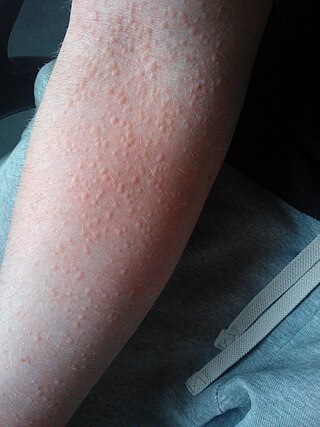Related Research Articles

Mastocytosis, a type of mast cell disease, is a rare disorder affecting both children and adults caused by the accumulation of functionally defective mast cells and CD34+ mast cell precursors.

Hives, also known as urticaria, is a kind of skin rash with red, raised, itchy bumps. Hives may burn or sting. The patches of rash may appear on different body parts, with variable duration from minutes to days, and does not leave any long-lasting skin change. Fewer than 5% of cases last for more than six weeks. The condition frequently recurs.

Cold urticaria is a disorder in which large red welts called hives (urticaria) form on the skin after exposure to a cold stimulus. The hives are usually itchy and often the hands and feet will become itchy and swollen as well. Hives vary in size from about 7 mm in diameter to as big as about 27 mm or larger.
Aquagenic pruritus is a skin condition characterized by the development of severe, intense, prickling-like epidermal itching without observable skin lesions and evoked by contact with water.

Urticaria pigmentosa (also known as generalized eruption of cutaneous mastocytosis (childhood type) ) is the most common form of cutaneous mastocytosis. It is a rare disease caused by excessive numbers of mast cells in the skin that produce hives or lesions on the skin when irritated.

Physical urticaria is a distinct subgroup of urticaria (hives) that are induced by an exogenous physical stimulus rather than occurring spontaneously. There are seven subcategories that are recognized as independent diseases. Physical urticaria is known to be painful, itchy and physically unappealing; it can recur for months to years.

Cholinergic urticaria is a type of hives (urticaria) that is triggered by an increase in body temperature, such as during exercise, sweating, or exposure to heat. It is also sometimes called exercise-induced urticaria or heat hives. The condition is caused by an overreaction of the immune system to the release of histamine and other chemicals in response to the increase in body temperature. This results in the characteristic red, itchy, and sometimes raised bumps or welts on the skin that are associated with hives.
Aquagenic urticaria, also known as water allergy and water urticaria, is a rare form of physical urticaria in which hives develop on the skin after contact with water, regardless of its temperature. The condition typically results from contact with water of any type, temperature or additive.
Drug-induced urticaria occurs by immunologic and nonimmunologic mechanisms, urticaria most commonly caused by aspirin and NSAIDs.
Adrenergic urticaria is a skin condition characterized by an eruption consisting of small (1-5mm) red macules and papules with a pale halo, appearing within 10 to 15 min after emotional upset. There have been 10 cases described in medical literature, and involve a trigger followed by a rise in catechomines and IgE. Treatment involves propranolol and trigger avoidance.
Heat urticaria presents within five minutes after the skin has been exposed to heat above 43 °C (109 °F), with the exposed area becoming burned, stinging, and turning red, swollen, and indurated.
Pressure urticaria is a physical urticaria caused by pressure applied to the skin, and is characterized by the development of swelling and pain that usually occurs 3 to 12 hours after local pressure has been applied.
Vibratory angioedema is a form of physical urticaria that may be an inherited autosomal dominant trait, or may be acquired after prolonged exposure to occupational vibration.
Contact stomatitis is inflammation or pain of the oral mucosa caused by external stimuli. It is characterized by cutaneous lesions that may be located where the offending agent contacts the mucosa for a prolonged time. Oftentimes it presents in the mouth after contact with hot food or from ill-fitted dentures or other irritant. Consequently, patients may seek resolve from their dentist rather than a dermatologist. Unlike with allergic contact stomatitis, the skin requires no previous exposure to a stimulant before crafting an immune reaction.
There are several distinct urticarial syndromes including:

UV-sensitive syndrome is a cutaneous condition inherited in an autosomal recessive fashion, characterized by photosensitivity and solar lentigines. Recent research identified that mutations of the KIAA1530 (UVSSA) gene as cause for the development of UV-sensitive syndrome. Furthermore, this protein was identified as a new player in the Transcription-coupled repair (TC-NER).
Urticarial dermatoses are distinct from urticaria, which examples being drug-induced urticaria, eosinophilic cellulitis and bullous pemphigoid. It is important to distinguish urticaria from urticarial dermatoses. The individual wheals of urticaria are ‘here today and gone tomorrow’, whereas with urticarial dermatoses, the individual lesions last for days or longer.
Urticaria-like follicular mucinosis is a rare cutaneous disorder that occurs primarily in middle-aged men.
Urticarial allergic eruption is a cutaneous condition characterized by annular or gyrate urticarial plaques that persist for greater than 24 hours.
References
- ↑ Rapini, Ronald P.; Bolognia, Jean L.; Jorizzo, Joseph L. (2007). Dermatology: 2-Volume Set. St. Louis: Mosby. p. 267. ISBN 978-1-4160-2999-1.